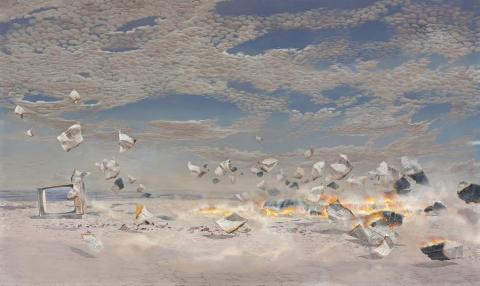THE CACOPHONY OF WISDOM (AN ECONOMY OF DUST AND ASHES), 2003
TIM STORRIER
synthetic polymer paint on canvas
183.0 x 305.0 cm
signed lower right: Storrier
inscribed and dated verso: 'The Cacophony of Wisdom / (an Economy of Dust and Ashes' / 2003 numbered verso: 120 / TS
Gene and Brian Sherman collection, Sydney, purchased directly from the artist October 2003 (stamped verso)
Dust and Ashes, Sherman Galleries, Sydney, 11 September – 4 October 2003, cat. 4 (illus. on cover of exhibition catalogue)
McGregor, K., and Zimmer, J., Tim Storrier, Macmillan Art Publishing, Melbourne, 2007, (illus. pp. 120–121)
'Storrier's desertscapes have the essence of the pittura metaphysica, in that objects seem to be observed in the moment before or after some indeterminate, or indescribable event. Like the metaphysical painters, such as Giorgio de Chirico, Giorgio Morandi, Alberto Savinio and Filippo De Pisis, Storrier situates his objects in a poetic space, that intimate space of reverie which opens itself to the world. That is, he describes not only the physicality of things and beings but their psychic resonance, or atmospherics, relying on receding horizon lines, fugitive vanishing points, vertiginous perspectives and cast shadows to convey sensations of vastness, solitude, immobility, mystery, panic and ecstasy.'1
There is a certain sublime albeit harsh beauty to Tim Storrier's landscapes, a visual characteristic that is synonymous with the representation of the Australian outback. The unforgiving terrain, the brilliant light and the sheer vastness of space are quintessential elements of Storrier's idiosyncratic landscapes, as demonstrated in The Cacophony of Wisdom (An Economy of Dust and Ashes), 2003. Here, Storrier juxtaposes the beauty against the hostility of the outback, the burning embers against the blue sky, and the foreign man-made objects against the prehistoric land.
The dusty dry cracked earth is completely desiccated, forming a pattern that is reflected in the clouds that dominate the sky, creating a sense of entrapment despite the flat expansive plane that stretches to the horizon. The horizon, which is an integral aspect of his desertscapes, extends across the canvas but is largely obscured by the flaming sheets of newspaper that hover across the foreground and float away from the burning log. Burning fiercely, the log is almost at the point of obliteration, utterly consumed by the fire and serving as a constant visceral reminder of mortality and the brutal power of nature. To the left of the burning log sits an abandoned television screen. Alone and in the middle of nowhere, it appears to have been there for a long time and thus amalgamates with the landscape. The television and the burning sheets of newspaper are the only indications of human contact and yet there is no one around, creating a heightened sense of isolation.
Storrier's atmospheric and mesmerising landscapes, such as The Cacophony of Wisdom(An Economy of Dust and Ashes) evoke a variety of emotions, from despair and fear to hope and optimism. Despite the vulnerability of mankind, and that our fragile creations are at the mercy of the elements, it is those same forces of nature that provide the cycle of renewal after complete devastation.
1. Van Nunen, L., Point to Point: The Art of Tim Storrier, Craftsman House, Sydney, 1987, p. 25.
CASSI YOUNG
